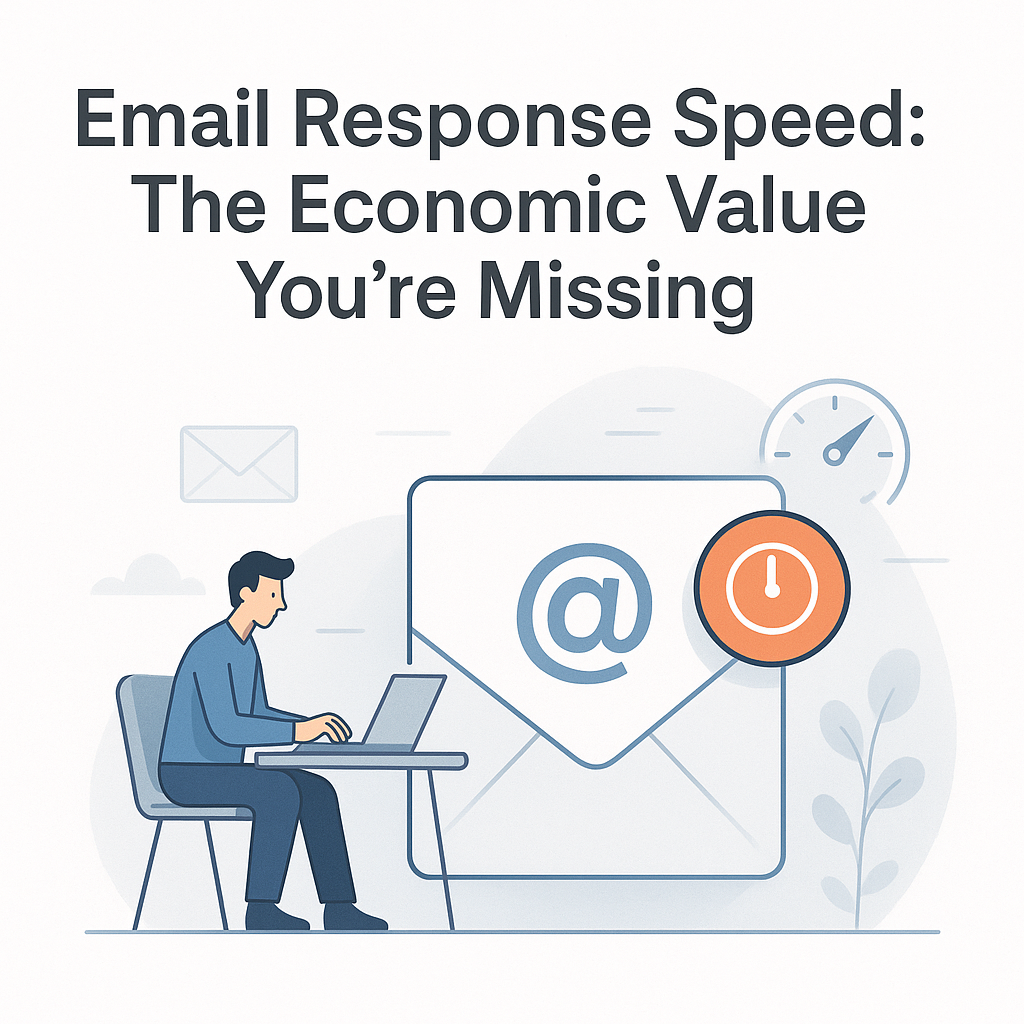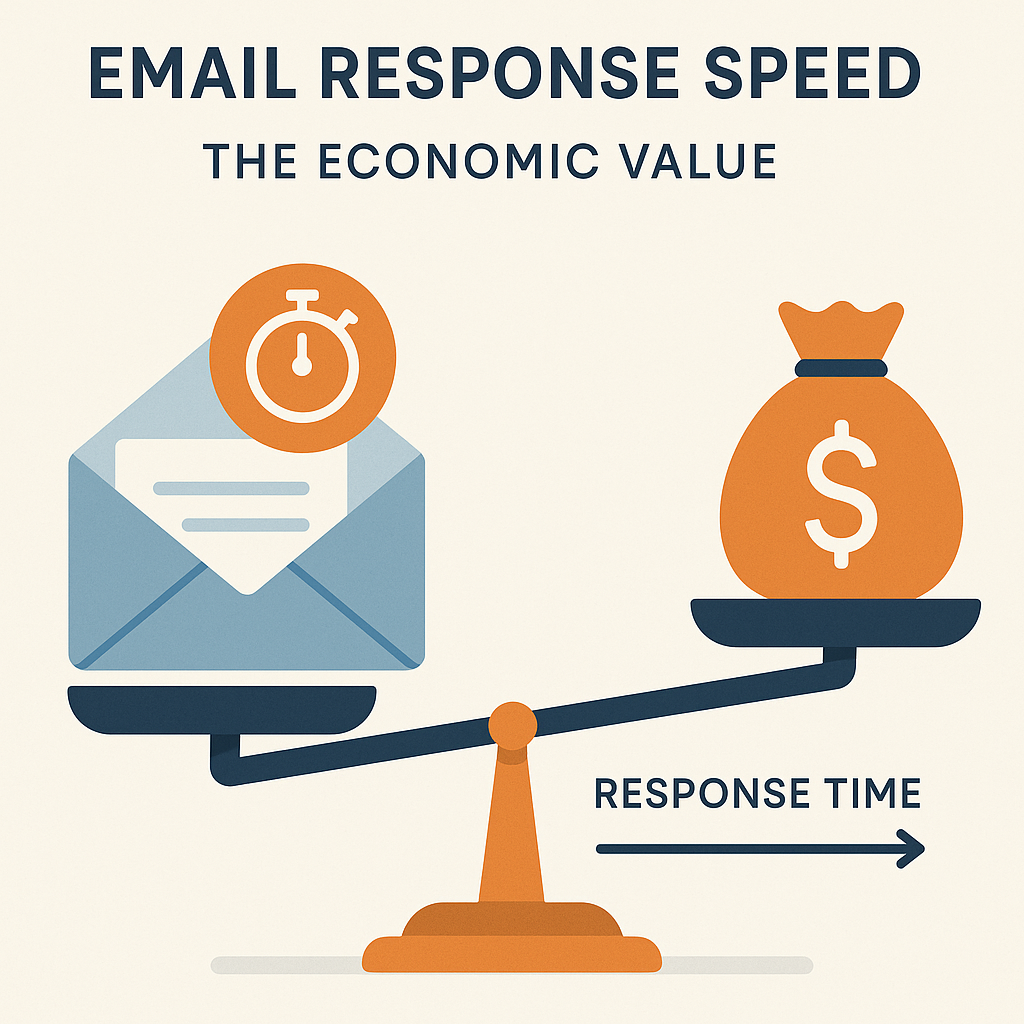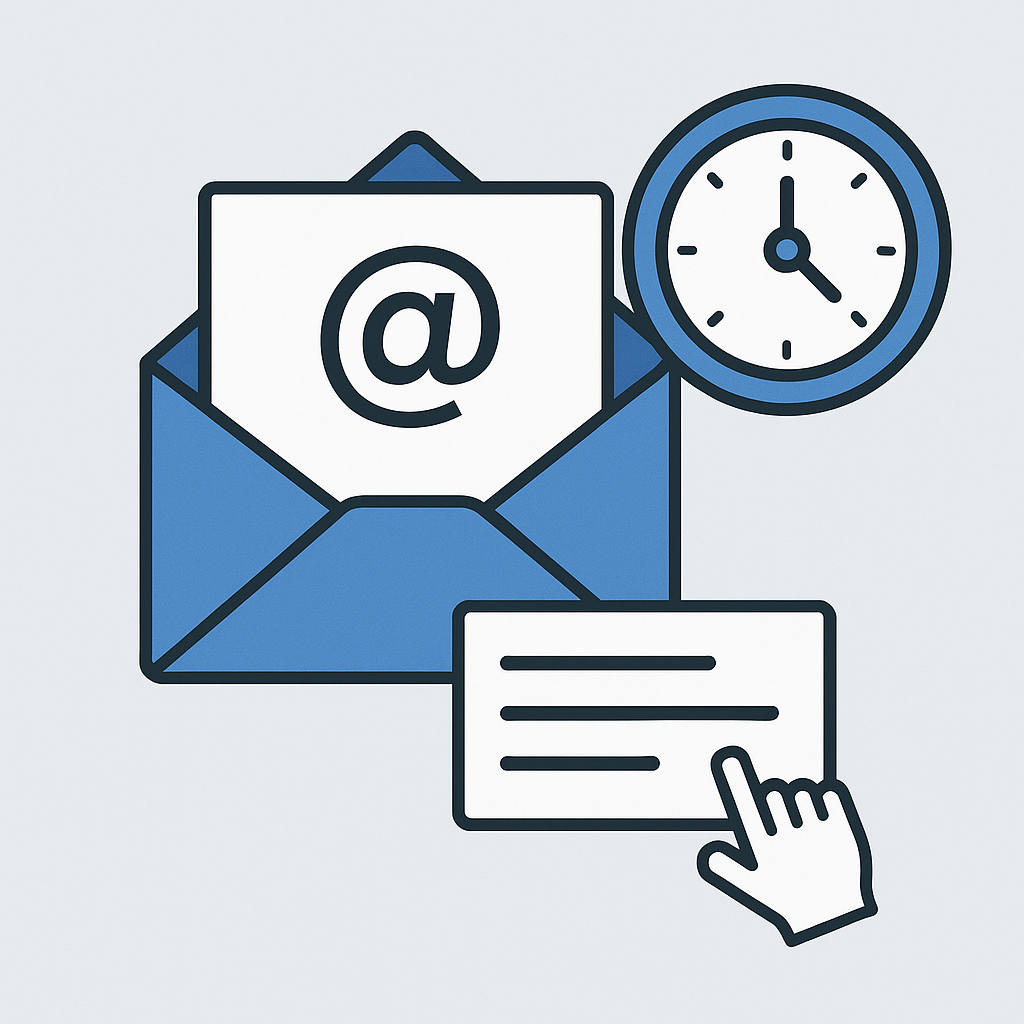Email Response Speed: The Economic Value You're Missing

In today's hyper-connected business world, the inbox can feel like a battlefield, a constant stream of requests, updates, and opportunities. For many professionals, especially busy executives, entrepreneurs, and sales teams, mastering email communication is more than just good etiquette; it's a critical driver of economic success. While we often focus on the content of our emails, a crucial, yet often overlooked, factor dictates their true business value: response speed. The time it takes to reply can directly impact your bottom line, influencing everything from sales conversions to customer loyalty and overall team productivity. Ignoring the economic value of fast email responses means leaving significant revenue and growth opportunities on the table.
The Hidden Economic Cost of Slow Email Responses
The sheer volume of emails we receive daily can be overwhelming. The average business professional spends a significant portion of their day managing their inbox, and slow response times can exacerbate this, creating bottlenecks that ripple throughout an organization. What’s the actual cost of a delayed reply? It’s multifaceted and often underestimated.
Firstly, there's the direct loss of opportunity. In sales, speed is paramount. A potential customer reaching out is at their peak of interest. If they don't receive a timely response, their attention can easily shift to a competitor who is quicker to engage. Research indicates that the average email response time across industries can be quite long, with one report noting it can stretch to over 11 hours and 42 minutes. In a competitive landscape, this lag time is a significant disadvantage. This delay can translate directly into lost leads and, consequently, lost revenue. For every hour a lead waits for a response, the probability of conversion can decrease dramatically.
Beyond lost sales, slow email responses can severely damage a company's reputation. In our 'always-on' economy, customers and clients expect prompt communication. Failing to meet these expectations can signal unreliability, poor customer service, or a lack of responsiveness. This can lead to negative reviews, word-of-mouth dissatisfaction, and ultimately, a tarnished brand image. Rebuilding trust and a positive reputation after it's been damaged is far more costly than preventing the damage in the first place.
Furthermore, slow email turnaround times create internal inefficiencies. When an employee’s ability to complete a task is held up by a delayed email response from a colleague or another department, it creates a domino effect. Projects get delayed, collaboration suffers, and overall team productivity plummets. This creates a culture of waiting rather than doing, impacting morale and efficiency.
How Faster Replies Directly Boost Sales and Lead Conversion
The connection between email response speed and sales success is perhaps the most tangible economic benefit. In the sales cycle, every interaction is an opportunity to build rapport, demonstrate value, and move a prospect closer to a purchase. Speed of response is a critical factor in capitalizing on these opportunities.
Studies have shown a dramatic impact. According to Forbes, responding to a lead within an hour can increase your success rate by an astonishing 700%. This isn't just a marginal improvement; it's a fundamental shift in conversion probability. Imagine a sales team that consistently responds to inquiries within minutes versus one that takes hours or even days. The difference in closed deals and revenue generated will be substantial.
Fast responses in sales demonstrate several key qualities to potential clients:
- Proactiveness: It shows you are engaged and eager to help.
- Professionalism: It signals efficiency and a commitment to service.
- Customer Focus: It indicates that their needs are a priority.
- Competitiveness: It positions you ahead of slower competitors.
For sales professionals, leveraging sales productivity tools that help manage and prioritize incoming leads and inquiries is not just about efficiency; it's about maximizing conversion rates and driving revenue growth. Tools that enable quick, personalized responses can be a significant competitive advantage.
The Link Between Reply Speed and Customer Loyalty/Retention
Beyond acquiring new customers, retaining existing ones is vital for sustainable business growth. Customer loyalty is built on trust, satisfaction, and positive experiences, and email communication plays a significant role in fostering these elements.
Customers expect quick and effective responses to their queries, especially when they are seeking support or information. When a customer reaches out with a question or a problem, their primary goal is resolution. A slow response time can lead to frustration, a feeling of being undervalued, and potentially, a decision to take their business elsewhere. As noted by timetoreply, a quick email reply time is essential to every successful customer service strategy, creating a smooth, positive customer experience that boosts satisfaction.
Conversely, prompt and helpful email responses can:
- Enhance Customer Satisfaction: Resolving issues quickly leaves customers feeling valued and well-supported.
- Build Trust: Consistent, fast communication builds confidence in your brand.
- Reduce Churn: Satisfied customers are less likely to look for alternatives.
- Increase Lifetime Value: Loyal customers tend to spend more over time and become brand advocates.
Improving customer service response speed isn't just about hitting a KPI; it's about strengthening customer relationships, which has a direct positive impact on long-term revenue and brand equity. Fast, efficient communication is a cornerstone of excellent customer experience.
Impact of Email Reply Time on Team Productivity and Collaboration
The internal consequences of slow email responses are often less visible but equally damaging to a business's economic health. When communication channels become clogged or delayed, it can significantly hinder team productivity and collaboration.
Consider a scenario where a project manager needs information from a team member to finalize a report. If that team member is slow to respond to the email request, the project manager is blocked. This delay might cascade, impacting deadlines, client deliverables, and the ability of other team members to proceed. This creates a ripple effect of reduced efficiency across departments.
Slow email turnaround times can lead to:
- Increased Communication Friction: Employees may resort to less efficient methods (like instant messaging for complex issues) or simply wait, leading to frustration.
- Task Bottlenecks: As mentioned, one delayed email can halt progress on multiple fronts.
- Wasted Time: Employees might spend time chasing up delayed responses or trying to find information elsewhere.
- Reduced Collaboration: When communication is slow and cumbersome, the natural inclination to collaborate can diminish.
Strategies for improving email response time optimization internally are crucial for fostering a productive work environment. For instance, implementing clear internal communication protocols and utilizing tools that help manage and delegate tasks can make a significant difference. You can learn more about how to boost email productivity with AI task delegation to streamline internal workflows and reduce communication bottlenecks.
Quantifying the Value: Calculating the ROI of Faster Email Responses
To truly understand the economic value of email response speed, businesses need to quantify it. While some benefits, like reputation, are qualitative, others can be measured directly in financial terms. Calculating the Return on Investment (ROI) for improving response times can help justify investments in tools and training.
Here’s how you can start quantifying the value:
- Measure Current Response Times: Use analytics tools or manual tracking to establish your baseline average response time for different types of inquiries (sales leads, customer support, internal requests).
- Estimate Lost Revenue from Slow Sales Responses:
- Identify the average value of a lead.
- Track conversion rates based on response time. For example, if a 1-hour response converts 70% better than a 12-hour response, calculate the potential lost revenue from those slower responses.
- If a sales rep handles 10 leads per day, and improving response time by 4 hours increases conversion by 10%, calculate the additional revenue generated daily, weekly, and monthly.
- Calculate Savings from Improved Customer Retention:
- Understand the cost of acquiring a new customer versus retaining an existing one (often 5-25 times more expensive to acquire).
- Estimate the percentage of customer churn attributable to poor communication.
- If faster responses reduce churn by even 1%, calculate the retained revenue.
- Quantify Productivity Gains:
- Estimate the amount of time employees spend waiting for responses or managing email backlogs.
- Calculate the value of this reclaimed time in terms of output or cost savings. For example, if 10 employees save 30 minutes per day on email management, that's 5 hours of productive time saved daily.
By applying these metrics, you can build a compelling business case for prioritizing email response speed value. This approach transforms a best practice into a measurable economic driver for your business, highlighting the importance of business communication economics.
Strategies and Tools to Drastically Improve Your Email Reply Speed
Improving your email response speed doesn't require a complete overhaul of your communication strategy, but rather a focused application of best practices and the right tools. Here are actionable strategies:
1. Prioritize Ruthlessly
Not all emails are created equal. Develop a system for categorizing and prioritizing incoming messages. Sales leads and urgent customer issues should take precedence over less time-sensitive internal updates. Tools that offer advanced inbox filtering and sorting can be invaluable.
2. Utilize Email Templates and Canned Responses
For frequently asked questions or common inquiries, pre-written templates can save immense amounts of time. Ensure these templates are well-crafted, professional, and easily customizable to add a personal touch. This is a fundamental email response best practice.
3. Implement Time Blocking
Dedicate specific blocks of time in your schedule solely for responding to emails. This prevents constant interruptions and allows you to focus on clearing your inbox efficiently. Avoid checking email reactively throughout the day.
4. Leverage Productivity Tools
There are numerous tools designed to enhance email management. This includes email tracking, scheduling tools, and CRM integrations that provide context for customer interactions. For those using Gmail, learning how to organize emails on Gmail effectively can be a significant first step.
5. Delegate and Automate
If possible, delegate email management tasks to team members or virtual assistants. For routine inquiries or follow-ups, automation can handle the initial response, freeing up your time for more complex interactions. This is where AI-powered solutions shine.
6. Set Clear Expectations
Communicate your expected response times to clients and colleagues. This manages expectations and reduces the pressure for immediate, on-the-spot replies for non-urgent matters. A clear policy on reducing email turnaround time can benefit the entire organization.
7. Inbox Zero Philosophy (or Close to It)
While achieving true "Inbox Zero" daily might be aspirational for some, adopting principles like processing emails in batches, archiving or deleting what's not needed, and ensuring every email has a clear next step can drastically reduce clutter and improve response efficiency.
Leveraging AI for Real-Time Email Management and Rapid Responses
The advancements in Artificial Intelligence (AI) are revolutionizing how we manage our inboxes. AI-powered tools can automate many of the time-consuming aspects of email communication, enabling faster, more efficient, and more strategic responses. This is particularly beneficial for busy professionals looking to optimize their workflows and gain a competitive edge.
AI can assist in several key areas:
- Smart Triage and Prioritization: AI algorithms can analyze incoming emails, identify urgency, categorize them, and flag them for immediate attention, ensuring critical messages aren't missed.
- Automated Responses: For common queries or status updates, AI can draft and send appropriate responses automatically, often personalizing them based on available data.
- Drafting Assistance: AI can help compose emails faster by suggesting content, correcting grammar and tone, and even summarizing long email threads.
- Action Item Extraction: AI can identify tasks, deadlines, and follow-up items within emails, helping users stay organized and accountable.
- Intelligent Scheduling: AI can suggest optimal times to send emails for maximum engagement or schedule your own responses to avoid interrupting others' focus time.
For those juggling complex inboxes and demanding schedules, modern tools can be a game-changer. Consider leveraging an ai executive assistant like those offered by MailToPie to help streamline your workflow, automate routine responses, and prioritize critical communications. Such solutions are designed to enhance email response time optimization, turning rapid replies into a measurable economic driver.
By integrating AI into your email management strategy, you can significantly reduce the time spent on administrative tasks, allowing you to focus on high-value activities that drive business growth. This is a key aspect of effective AI email management.
Case Studies: Businesses Thriving with a Fast-Response Culture
While specific company data is often proprietary, the principles of a fast-response culture are evident across successful businesses. Let's consider hypothetical yet common scenarios:
Scenario 1: The E-commerce Startup
An online retailer faces a high volume of customer inquiries regarding orders, shipping, and product information. By implementing a system that prioritizes support emails and uses AI to answer common questions instantly, they reduce their average response time from 8 hours to under 1 hour. This leads to a measurable increase in customer satisfaction scores, a reduction in negative reviews, and a significant boost in repeat customer rates, directly impacting revenue.
Scenario 2: The B2B Sales Agency
A sales agency realizes their lead conversion rates are lagging. They implement a strict policy of responding to all new inquiries within 30 minutes, supported by CRM integrations that provide prospect data. They also train their sales team on using email templates for common follow-ups. Within a quarter, they see a 20% increase in qualified leads converted to clients, attributing much of this success to their improved customer communication efficiency.
Scenario 3: The Consulting Firm
A consulting firm often receives complex project-related emails from clients and partners. Slow internal communication was causing project delays. By adopting better internal email management practices, including time blocking for responses and utilizing AI for task delegation within emails, they reduced project turnaround times by 15%. This improved client satisfaction and allowed consultants to take on more projects, increasing the firm’s overall output and profitability.
These examples highlight how a commitment to faster, more efficient email communication can yield tangible economic benefits, from increased sales and customer loyalty to improved operational efficiency. Embracing a fast-response culture is not just about good service; it's a strategic business imperative.
In conclusion, the email response speed value is undeniable. It's a critical, yet often underestimated, factor in driving sales, fostering customer loyalty, and enhancing team productivity. By understanding the economic costs of delays and implementing effective strategies—augmented by powerful AI tools like an ai executive assistant—businesses can transform their email communication from a time drain into a significant economic advantage. It's time to make speed and efficiency a core component of your communication strategy and unlock the full economic potential of your inbox.
```


